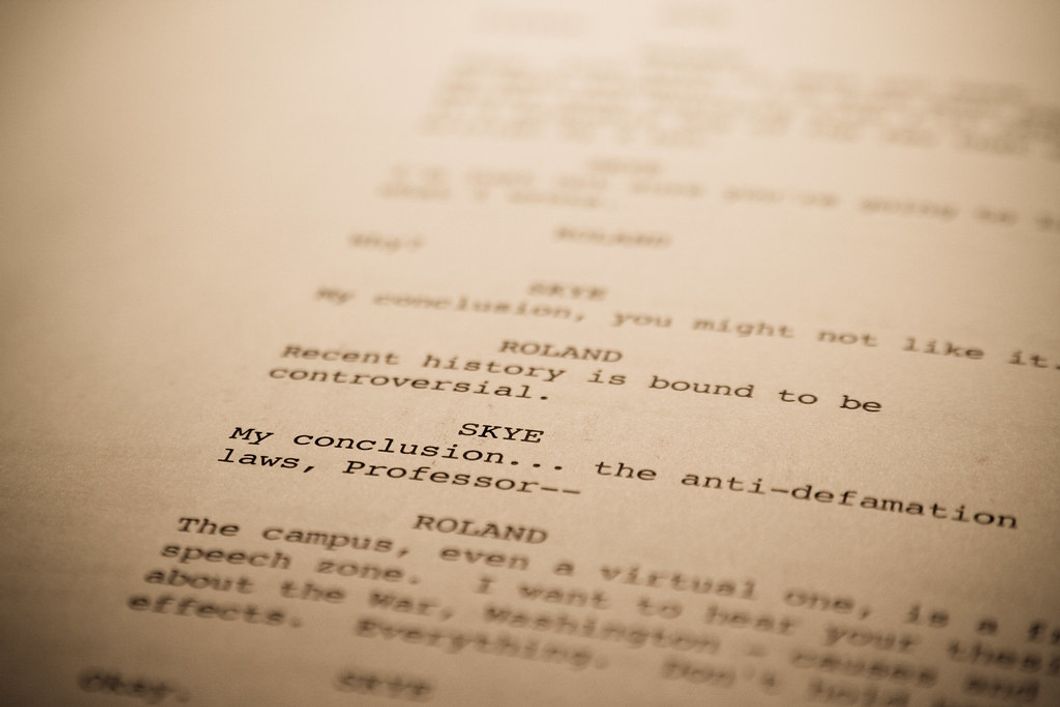Since I have always been interested in film and television, it is safe to say that I also have a big interest in the witing or production aspect of it as well. As an English major, how could I not be interested in the written craft? In fact, I have found so much enjoyment in the creative process that I have picked up a screenwriting minor and I hope to find myself writing scripts for my own shows one day. As I have exercised my craft, I have learned new skills an dtricks that really have helped me polish my screenwriting skills. If you are interested in screenwriting or just in the process behind screenwriting, these quick tips are for you.
1. Fully Capitalize the Names of New Characters

https://www.flickr.com/photos/joeflood/2406045809/in/photostream/
This is just a little trick that really helps distinguish characters. Of course, character names are always capitalized in dialogue, but when we are introducing a character in the general script description/action, it is important to put their name in all-caps. By doing so, we know that this is a completely new character who is entering the scene and not one that we have seen before in the story; now, we are on high alert for new details or description that will come after.
2. Avoid Writing Small Actions
 Screenwriter Youtuber Filmmaker Writing Script
Screenwriter Youtuber Filmmaker Writing Scripthttps://www.maxpixel.net/Screenwriter-Youtuber-Filmmaker-Writing-Script-2838932
As someone who loves to write, this one is a bit hard to follow in the beginning. We are empathetic creatures and we are tempted to write the action as we would see or experience it. Thus, we get sentences like "he prepared to walk over" or "she was going to start opening the letter." In theory, these sentences are fine, but screenplays go by very quickly in terms of writing and dialogue so it is great to compress wherever we can.
3. Only Write what We would See or Know

https://www.flickr.com/photos/karmagrrrl/8374376925
As the creators of our screenplays, we are usually excited to reveal information about our characters; these fictional beings are our own creations and we want to show them off with pride. However, it is very important to remember that as writers, we should only really write what our audience would see or know from watching. For exmpale, an audience member who is just introduced to a character woudln't know that a character is quick-witted or sarcastic. Those come with dialogue and further character study.
4. All Scene Location Changes Need Three Core Things
 Film Maker Filmmaking Film Screenplay Industry
Film Maker Filmmaking Film Screenplay Industryhttps://www.maxpixel.net/Film-Maker-Filmmaking-Film-Screenplay-Industry-2651055
When we have changes in location or scene, we always include at least three things at the top of the scene. First, we let our readers know if our scene is inside or outside (INT. or EXT.). Next, we give them a little information about where they are in this fictional world. Are we in "GEORGE'S LIVING ROOM" or "AN OLD CLASSROOM?" Lastly, we let our readers know what time of day it is in your screenplay. These are the three core things that go on top of every scene change and they really help give readers an idea of what is going on in the script.
5. Don't Write Description/Action like a Novel

https://www.flickr.com/photos/jp_teti/8524851932/in/photolist-dZj6tJ-nWsBLs-kd59D4-8LioEf-8XAQgG-81eP3N-7XvjRx-VXEsDH-9gcYWx-fWFkHX-6aB2Hd-6QbxHL-62y43J-8dHdb5-9DYqAn-bV75ou-4UrabA-2314X7h-gkvseL-Qqszpd-bg9KKr-8tTMD3-fPjCr2-avn3uF-7i7taj-6VYSth-ijZN9S-8WxDdq-2b5kcjx-iZfcSf-FKeDP8-q2xji5-VBcyBt-aaMU4e-cijzoW-ouMap9-fu836H-a1Hbw7-9UDuzP-WrLBGN-BciaR-uNABe-ecdiDc-8GDz88-guS8S-oLWZuM-akWwGp-7Ys2ir-8Z7a3u-Bcibp
If you are used to writing prose, it is so tempting to bust out long and lavish descriptions in yoru screenplay. However, your screenplays need ot have flow on paper as well as on the screen. Thus, it is very important that you try and avoid long and chunky blocks of text in your screenplay. Not only does it look daunting on paper, but it slows down our reading and breaks up the overall flow of the script.
6. Parantheticals Are Key to Small Character Cues

https://www.flickr.com/photos/nationalmuseumofamericanhistory/8405731337
In a format that requires you to make every description and piece of dialogue count, it is hard to find time to express small character tones or actions. That is why, we have a lovely thing called paranteticals that get this information across. Place a quick little note such as "wispers" or "sarcastically" in parantheses below or beside the character's name as it is used in dialogue and you are good to go. You now have delievered information to the reader and the reader now has the tools needed to understand a piece of dialogue's tone or character intent.
7. Don't be Afraid to Experiment Formatting

https://www.flickr.com/photos/45511562@N04/4617361314
With rules in place, one would think that screenplays have little room for experimentation or free form style. While there are many rules in place, there are many parts of the script that are left open to author interpretation of style. For example, you could write a flashback scene many different ways as well as a scene where the action on the screen is splitting the screen in half. There are so many fun design aspects of screenwriting that don't have a set format and it is always fun to see what works and what doesn't work with each, individual piece.
Overall, screenwriting, like other forms of storytelling, is all about fun and creativity. I hope that these tips help you get started on future writing endeavors to come.















